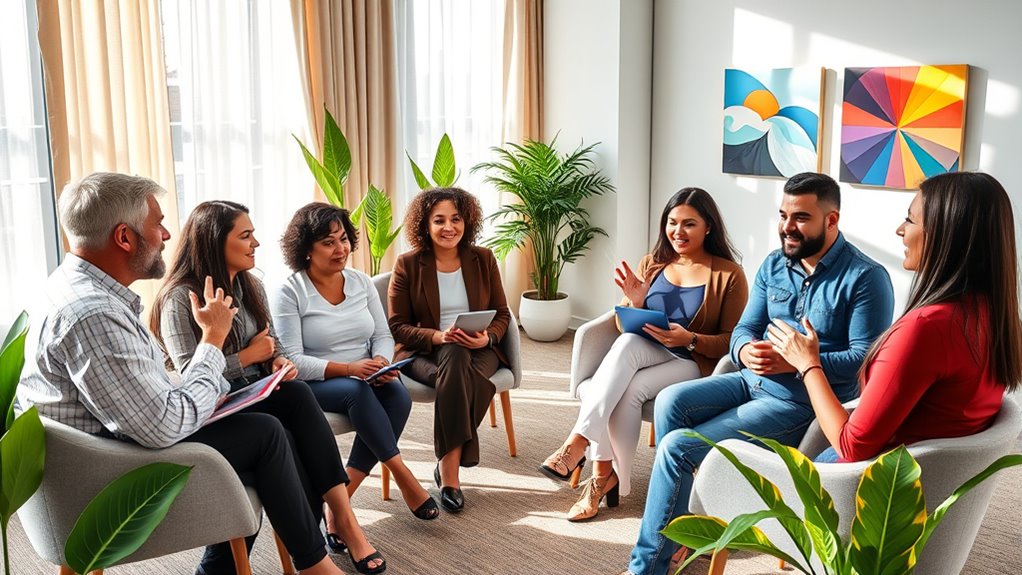To master small-group facilitation, focus on creating an inclusive, trusting environment by showing genuine respect and cultural awareness. Practice active listening and ask open-ended questions to encourage participant engagement. Manage diverse perspectives by staying neutral and emphasizing common goals, while keeping discussions focused with clear goals and time management. Use techniques like icebreakers and visual aids to boost participation. Keep exploring these skills further to open more effective facilitation techniques and enhance your group dynamics.
Key Takeaways
- Establish clear goals and boundaries to keep discussions focused and purposeful.
- Use active listening and open-ended questions to encourage sharing and deepen understanding.
- Foster an inclusive environment by respecting diverse perspectives and managing conflicts constructively.
- Promote participation through icebreakers, visual aids, and rotating speaking opportunities.
- Maintain momentum and time management with a visible agenda and problem-solving techniques.
Building an Inclusive and Trusting Environment

Creating an inclusive and trusting environment begins with setting clear intentions and demonstrating genuine respect for every participant. Cultivating cultural awareness helps you recognize and honor diverse perspectives, fostering a sense of safety. Emotional intelligence allows you to read the room, respond empathetically, and manage your reactions effectively. When you show authentic interest and appreciation for different backgrounds, trust naturally builds. Be mindful of subtle cues and validate each person’s contribution, reinforcing a welcoming atmosphere. Your ability to navigate cultural differences and exhibit empathy encourages openness and honesty. This foundation of respect and understanding empowers participants to share freely, knowing they’re valued and understood. Ultimately, your awareness of cultural nuances and emotional intelligence cultivate a space where everyone feels included and trusted.
Active Listening and Thoughtful Questioning

Active listening and thoughtful questioning are essential skills for guiding meaningful group conversations. When you practice reflective listening, you demonstrate your understanding by paraphrasing what participants share, which encourages openness and trust. Use open-ended questions to invite deeper discussion and explore ideas more thoroughly. These questions can help participants clarify their thoughts and express themselves fully, fostering engagement. Active listening involves giving your full attention, maintaining eye contact, and avoiding interruptions. Combine this with thoughtful questioning to create a safe space where everyone feels heard and valued. By honing these skills, you can facilitate more dynamic, insightful conversations that lead to productive group outcomes. These techniques ensure discussions stay focused, inclusive, and stimulating for all involved.
Managing Diverse Perspectives and Conflicts

Building on your skills in active listening and thoughtful questioning, managing diverse perspectives and conflicts requires a mindful approach. When steering through cultural differences, it’s essential to stay open and respectful. Use these strategies:
Embrace cultural differences with openness and respect to effectively manage diverse perspectives and resolve conflicts.
- Recognize cultural differences and avoid assumptions.
- Encourage everyone to share their viewpoints without interruption.
- Facilitate conflict resolution by focusing on common goals.
- Stay neutral, and help the group find solutions rather than assign blame.
Keeping Discussions Focused and Productive

To keep discussions focused and productive, it’s essential to set clear goals and boundaries from the start. Clearly define what you want to achieve, which helps guide the conversation and prevents digressions. Use problem solving techniques to address issues efficiently, ensuring the group stays on track. Implement effective time management by allocating specific time slots for each topic or activity, and gently steer the discussion back if it drifts. Keep a visible agenda to remind everyone of the objectives. As a facilitator, your role is to maintain momentum without rushing, balancing thorough exploration with efficiency. These strategies help create a focused environment where ideas are explored meaningfully, and tangible outcomes are achieved without unnecessary delays.
Encouraging Participation and Facilitating Engagement

Once you’ve established clear goals and kept the discussion on track, the next step is to guarantee everyone feels motivated and comfortable contributing. To promote participation:
- Use icebreaker activities to create a relaxed atmosphere and help members connect.
- Incorporate visual aids to clarify points and make discussions more engaging.
- Ask open-ended questions that invite diverse perspectives.
- Rotate speaking opportunities so everyone has a chance to contribute.
These strategies make it easier for participants to share ideas and stay engaged. Icebreakers break down barriers, while visual aids enhance understanding. By actively encouraging input and making the environment welcoming, you foster meaningful engagement and a more productive group dynamic.
Frequently Asked Questions
How Can I Handle Dominant Participants Without Discouraging Them?
When handling dominant participants, you focus on balancing participation to guarantee everyone’s voice is heard. Gently acknowledge their input, then redirect the conversation to encourage quieter members to share. Use inclusive language like, “Let’s hear from someone who hasn’t spoken yet,” to maintain engagement without discouraging the dominant person. This approach fosters a collaborative environment, helping all participants contribute comfortably and confidently.
What Are Effective Ways to Manage Group Anxiety or Hesitation?
Oh, managing group anxiety? Easy, right? Just tell everyone to relax and jump in. In reality, you can help by guiding them through simple breathing exercises—slow, deep inhales and exhales. Use positive reinforcement to praise their efforts, which builds confidence. These techniques encourage hesitation to fade, making participants more comfortable and willing to contribute. Remember, a calm group starts with your calm leadership.
How Do I Adapt Facilitation to Virtual or Hybrid Settings?
When adapting facilitation to virtual or hybrid settings, you should focus on boosting virtual engagement by using interactive tech tools like polls, chat, and breakout rooms. Keep sessions dynamic and encourage participation through clear instructions and frequent check-ins. Guarantee your tech setup is reliable, and be ready to troubleshoot. Your goal is to foster an inclusive environment where everyone feels comfortable contributing, regardless of the setting.
What Techniques Promote Creative Thinking Within Small Groups?
Ever wonder how to spark creativity in your group? You can boost inventive thinking by using brainstorming techniques that encourage free idea flow and discourage judgment. Incorporate idea mapping to visually organize thoughts, making connections clear and inspiring new perspectives. Asking open-ended questions and creating a safe space for all voices to contribute also fuels innovation. These methods help your group think outside the box and generate fresh, innovative ideas.
How Can I Assess the Success of My Facilitation Efforts?
To assess your facilitation success, focus on participant feedback and session reflection. Ask attendees for honest feedback about the session’s effectiveness and engagement. Afterward, reflect on how well the group stayed on topic, participated actively, and achieved objectives. Look for patterns in feedback and your own observations to identify strengths and areas for improvement. This combination helps you gauge impact and refine your facilitation skills over time.
Conclusion
By mastering small-group facilitation skills, you create a confident, cohesive, and collaborative climate. Cultivate connection through compassionate listening, constructive questioning, and conflict resolution. Keep conversations clear, compelling, and inclusive to inspire involvement and ignite ideas. With deliberate dedication and dynamic delivery, you’ll develop a dependable environment where every voice is valued, and every discussion drives meaningful momentum. Embrace these essential skills to empower, engage, and elevate every group experience you foster.










